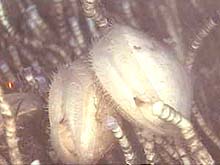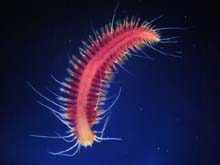
A close-up view of Acesta clams found on tubeworm bushes. Notice that the clam is at the apical end of the tubeworm, lending support to the hypothesis that they eat the tubeworm eggs as they are spawned.
Collecting Tubeworms and Their Resident Clams
Student Report
February 13, 2003
John J. Young, Master's Candidate
Oregon Institute of Marine Biology
University of Oregon
I woke up early this morning because it was my turn to make a dive in the Johnson Sea-Link II submersible. I was assigned to the aft compartment of the submersible, where it was my job to take notes about the dive. We were interested in observing the behavioral interactions of Acesta clams and tubeworms. Johanna Jarnegren hypothesized that the clams eat the eggs of the tubeworms as they release them during spawning. This hypothesis is reasonable, since the tubeworms continuously spawn, and clams are often found in close proximity to the openings of tubeworms.
The submersible hit the water at 8 am; we were on the bottom by 8:31 am. I was amazed at the density of life in this otherwise barren habitat. Fields of tubeworm "bushes" were home to hundreds of Acesta clams, as well as countless fish, shrimp, and crabs. I was so enthralled with this amazing deep-sea community that I forgot that it exists completely independent of light. This ecosystem derives its primary production from methane that seeps out through the sediment at the bottom of the Brine Pool. Bacteria capable of harnessing the energy from methane synthesize organic carbon, thereby forming the basis of this deep-sea food web. The tubeworms and mussels found in these habitats derive most, if not all, of their energy needs from these bacteria, which live symbiotically within them. I viewed this rich community firsthand through the porthole in the rear of the submersible, and it was more amazing than I had anticipated.
After filming and collecting tubeworms and Acesta clams, we went in search of bacterial mats and methane gas hydrates in hopes of finding iceworms. Many bacterial mats dotted the sediment. We sampled these mats by inserting a tube into the sediment, which removed a cylinder of the sample while maintaining its vertical structure. One of the scientists on board, interested in characterizing these deep-sea bacteria, later analyzed the samples.
Unfortunately, our search for gas hydrates and the accompanying iceworms was not fruitful. By 11 am, it was time to return to the surface. We began our ascent by inflating the ballast tanks and turning off the submersible's lights. With the lights out, we saw thousands of bioluminescent animals lighting the porthole like a magnificent blue fireworks display.
After the submersible was recovered and back aboard the ship, the collected samples were moved to the cold room and the crew prepared the submersible for the second dive of the day. On this dive, we collected more tubeworms and clams, and also found ssome iceworms! A considerable amount of excitement was generated when the submersible surfaced with these unusual animals. Many scientists participated in removing the worms from their tubes, measuring their length, and collecting their eggs for Johanna's feeding experiments.
Later, we towed a net called a MOCNESS, which is capable of opening and closing at different depths. This sampling took about 3 hrs, so it was 11 pm by the time we recovered the net and removed the samples. These samples, which contained organisms like eel larvae, hatchet fish, and luminescent mictophids, had to be fixed in formalin before being stored. By 1 am, our the work was done; after a full day of once-in-a-lifetime experiences, I was ready for bed!

Iceworms (Hesiocaeca methanicola) live within methane hydrates in the northern Gulf of Mexico. Click image for larger view.
Deploying 'Peepers' at Green Canyon
Student Report
February 13, 2003
Erich Fleming, Doctoral Candidate
Oregon Institute of Marine Biology
University of Oregon
We conducted two dives today in the Green Canyon area. The first dive crew left before I awoke, but they had collected some wonderful bacterial mats for me to examine. Deep-sea environments are unique in that they rely heavily on bacteria as the primary producers. On land and in the upper ocean, primarily plants and algae provide the primary production. But there is no light in the deep-sea, so only bacteria that use chemical reactions generate energy. The bacteria brought up during the first dive live in a community called a mat. These micro-ecosystems support many different forms of bacterial life, yet are only a few centimeters thick. Other deep-sea bacteria live inside other organisms, such as tubeworms and mussels, generating energy and food for their animal hosts.
I was on the second dive of the day at Green Canyon. We had multiple tasks to accomplish. First, we placed three "peepers" near tubeworm bushes. These long PVC pipes, with bags inside made of dialysis tubing, are placed vertically on the ocean floor. The dialysis bags have microscopic poles in them that allow small molecules to enter, but exclude larger particles such as silt. This apparatus allows us to determine how the chemical composition of the ocean floor changes with depth in different areas and what this means to the organisms living there.
Next, we collected iceworms! These worms burrow into the methane ice on the bottom of the ocean. The ones we collected today lay in little grooves on a small patch of bright yellow methane ice. Because of the high pressure and low temperature at this depth, methane can exist as ice, as opposed to its gaseous form at the surface. The worms were collected for study by the submersible's suction tube. Sample cores of the sediment were also collected around the methane ice deposit so microbiologists could study the bacterial communities living near the methane seep. On our way to our final destination, we took some time to wander around, seeking any interesting animals to collect and examine. We were extremely fortunate to find a couple of brittle stars, some crabs, and quite a few mussels.
Our last task was to film tubeworms spawning. Since we do not know exactly when they spawn, we had to rely on luck. Alas, luck wasn't with us today. We waited in front of a tubeworm bush for 35 min before we gave up and returned to the ship.
In the evening, we conducted our second MOCNESS tow. The seas were a little rough, but that did not stop our group of intrepid scientists. The MOCNESS is a set of nets that open and close individually at different depths, so that organisms living at different depths in the water column can be collected. We divided the contents of each net into large and small organisms. The organisms were then preserved for later examination. Most were small crustaceans and jellyfish. There were also many bioluminescent organisms in the samples, including various lanternfish, jellyfish and algae. When the sample was shaken, small balls of blue light would ignite for a short time, then fade away until it was shaken again.
I am truly in awe of the life that exists on the bottom of the ocean. Any similarities that the deep sea has to the rest of the world only accentuate how different and unique this environement really is.









